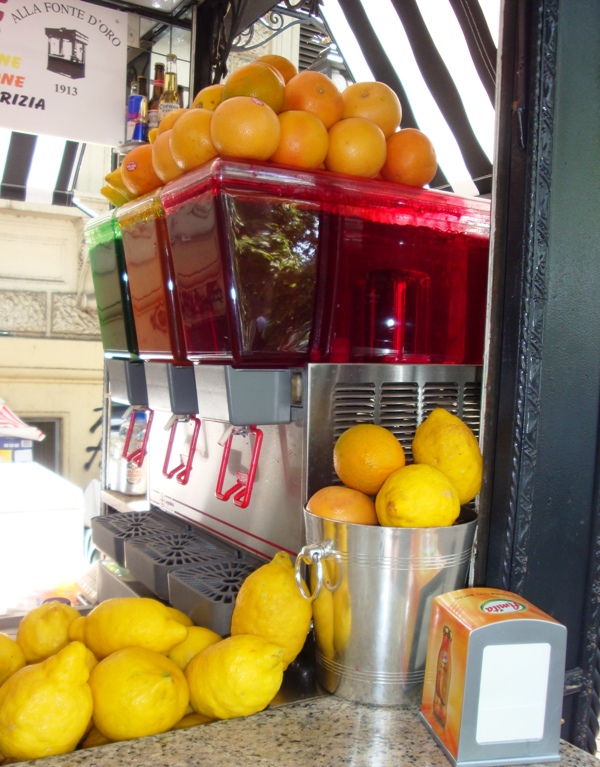
In May 2005, I sat down in my living room in Largo Arenula and wrote the following:
I just said goodbye to my best friend in the piazza beneath my house... "So many years, huh? So many years," he'd said. Six years of friendship in a foreign country can seem like a lifetime. And seeing that time together end can seem the end of a life, too. Well, at least the end of an era.
My friend Patrick had just left for the airport, to fly to the U.S., and to leave our adopted city of Rome, for good. I was reeling. Our friendship wasn't over, of course, but our time in Rome together was. We'd experienced so much, jam-packed into those six years, so many amazing memories. And since we were living in Italy, and I'm a chef -- well, many of those memories revolved around food.
Below: Patrick in front of his Trastevere apartment

It must be explained that left to his own devices, Patrick would have subsisted on a diet of fish sticks and toast, with the occasional PB and J or tuna fish sandwich thrown in for good measure. This is not because he was a difficult eater -- if placed in front of him, he would eat most anything, including healthy greens, salads, vegetables, meats, fish, and the numerous delicious pastas we were fortunate enough to be surrounded by in Rome. But Patrick did not prepare this fare for himself. His tiny kitchen corner in his Trastevere apartment didn't really allow for the preparation of anything beyond the super-simple. So I took it upon myself to feed Patrick when I could, with labor-intensive, sophisticated meals at my dinner parties, and, more frequently, with simple home-cooked meals I'd make for us at my apartment. Patrick would buzz the citofono downstairs between 4 and 4:30 p.m., on average, four days a week. I'd pick up the hand-held receiver to hear his cocktail hour credo: "It's 5 o'clock somewhere!" He'd climb the five long flights of stairs in the name of shared aperitivi (he kept a bottle of Jack Daniels stored in my liquor cabinet for convenience) and if we didn't go out after, he'd often stay for dinner and a movie. "Dumb and Dumber" and "Fargo" were our favorites. Each time he'd stay over for a meal he'd make me imitate the line from Fargo: "Daaaaad? Ya stayin' for supperrrrr?!" in a strong North Dakota accent. He laughed hysterically every time -- even this past December, over the phone, when I indulged his request for me to "Say the line! Say it!"

There was one year in Rome when we watched what was basically the Italian version of American Idol, "Operazione Trionfo" every Wednesday night. Patrick would come over an hour before it came on, for some pre-show libations. I'd make dinner. We'd discuss who we surmised wouldn't make the cut that week. Martin often joined as well. Our friends called us idiots, but they were missing out on cheesy Italian entertainment! One week, Patrick had decided he wanted to cook dinner for meinstead of the other way around. His dish of choice? Something he called his Mom's Special Fried Chicken -- that is, chicken drumsticks shaken in a bag with seasoned bread crumbs, then fried in a pan, until, a few minutes before the chicken was done, he dumped a cup of water into the pan. We'd debated about this for months on end: how could "fried chicken" remain fried if you then doused it with water? Wouldn't it just become soggy fried chicken? I never understood what made him wax poetic about this dish. And the irony, as it turned out, was that I had a terrible stomach flu the night he endeavored to recreate this dish at my apartment. I never got to try it. I was on saltines and San Pellegrino.

I always enjoyed pushing Patrick to his culinary limits. Our friend Anna, owner of our second-home bar, Stardust, would order crates of fresh oysters from Normandy around the holidays. One cold December night, Patrick and I were having drinks in the dimly-lit bar after dinner. Anna asked me if I knew how to shuck oysters -- and since I will happily suffer shucking for a taste of pure deliciousness, she told me to step behind the bar and prepare 6 or 8 oysters for us. Patrick got nervous. First because we were discussing ostriche (oh-stree-kay), the Italian word for oyster, which he assumed meant "ostrich." Once we cleared that up, he remained nervous because he'd never tried a raw oyster before. I brought over a plate of them with lemon wedges and some Tabasco sauce for the first-timer. By then, the entire bar had overheard our conversation, and everyone was rallying behind Patrick to slurp the briny bivalve from its shell. The next 20 seconds were hilarious, for the range of expressions that came across his face, and the trouble he had choking the thing down. Once he did, the bar erupted in cheers, as Patrick laughed, sheepishly proclaiming "mai piu'!" (never again!).

I reviewed restaurants for various guidebooks in Rome, and so frequently, I'd take friends along to help me "judge" a meal. Patrick was happy to accompany me on numerous occasions, the most memorable of which was our outing to Checchino, an old, elegant restaurant in the Testaccio neighborhood that's been around since 1887. Checchino is famous for perfecting the Roman cooking of the "quinto quarto" -- basically, it's the cheaper cuts of meat and organs and everything that makes up offal (and to Patrick's palate, AWFUL). We ordered some classic Roman pasta dishes, but I insisted that we also order a few of the more 'adventurous' dishes. Patrick was not a fan of liver, lungs, brain, or anything else that I made him try that afternoon, though we did have a fun time misbehaving in the starched-linen elegance of the restaurant. The topper was a bollito misto, traditional more of northern Italy but served here as a plate of mixed boiled animal parts with a piquant green sauce.

Now, I've had great versions of this dish. This was not one of them. The meat pieces were mostly gelatinous and jiggled when Patrick shook the plate. What didn't shake was overcooked and in the grayish-taupe color family. Present in the collection of meat-ish products were brain, tripe, and various sections of a cow's and pig's face. Patrick and I were only able to make a dent in the dish by coercion to eat specific parts: P: "I dare you to eat that gray slice of meat". D: "Only if you eat that jiggly piece of cartilage." P: "No way! Only if you eat that squiggly thing too." D: "Can I dump green sauce on it?" P: "Yeah, okay." D: "Deal." We laughed our way through lunch, and washed everything down with some crisp white wine. And chalked it up to another interesting Italian food experience.

Riding home on the back of Patrick's scooter, zipping along the Tiber River on a sunny afternoon, belly full: it was the height of contentment. It was another perfect moment in Rome, one of countless wonderful memories I have with Patrick.
I miss him every single day.
To Be Continued...


































































































